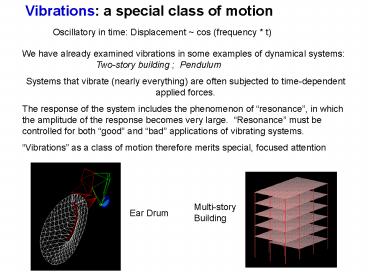Vibrations: a special class of motion - PowerPoint PPT Presentation
1 / 31
Title:
Vibrations: a special class of motion
Description:
The response of the system includes the phenomenon of 'resonance', in which the ... Railway Suspension Bridge, Niagara Falls 1860. Scope of Vibrations Lectures ... – PowerPoint PPT presentation
Number of Views:49
Avg rating:3.0/5.0
Title: Vibrations: a special class of motion
1
Vibrations a special class of motion
Oscillatory in time Displacement cos
(frequency t)
We have already examined vibrations in some
examples of dynamical systems Two-story
building Pendulum Systems that vibrate (nearly
everything) are often subjected to time-dependent
applied forces. The response of the system
includes the phenomenon of resonance, in which
the amplitude of the response becomes very large.
Resonance must be controlled for both good
and bad applications of vibrating
systems. Vibrations as a class of motion
therefore merits special, focused attention
Multi-story Building
Ear Drum
2
Desirable Vibrations
MRI
Time keeping
Atomic Force Microscopy
Ultrasound
3
Undesirable Vibrations
Tacoma Narrows Bridge (1940)
See videos on YouTube and a long one
on http//www.archive.org/details/SF121
4
Earthquake-induced Vibrational Failure Kobe,
Japan 1995 Sichuan Province, China, 2008
5
Vibration Control and Isolation
6
Low Tech Solution Railway Suspension Bridge,
Niagara Falls 1860
7
Scope of Vibrations Lectures
FREE Vibration provide initial conditions and
let system respond
Undamped
First Simplest system one degree of
freedom Then Vibration of systems (multiple
degrees of freedom)
Damped
8
Scope of Lectures
FORCED Vibrations Continuous forcing of the
system by an oscillating force or motion
9
All these pictures of springs But pictorial
examples dont have any springs Why ?
Many objects/structures behave like springs i.e.
Displacement is proportional to Force F -kx
Static measurement of deflections and forces can
be used to measure the effective spring constant
10
Result is some curve
11
Why is it always linear? When no forces are
exerted on a material, the atoms adjust
themselves to minimize the potential energy of
the material If the potential energy is a smooth
function of atom positions, then at the minimum
the energy must vary quadratically, not linearly
For a conservative system, force is the
derivative (gradient) of the energy, so
When you stretch a material, you are directly
measuring the atomic springs
12
Bending instead of stretching
h
b
Displacement versus Force is still linear
13
Equation of Motion for Free Vibrations One
Degree of Freedom ( one coordinate of motion)
Equation of Motion
or
14
Pendulum
We derived the equation of motion for the angle ?
previously
L
For small ?ltlt1
m
Same form as before
15
How about something a bit more complicated
16
A case of rotational oscillations
17
Always the Same Equation of Motion
Mass m on a spring
Pendulum
Two-mass/Pulley system
Rotating bar
Equation of Motion always of the form
M mass-like quantity K spring-like
quantity x position-like variable
18
Frequency the system wants to vibrate at if left
alone (unforced)
19
Solve the Equation of Motion
Homogeneous 2nd order, linear, ordinary
differential equation with constant coefficients
Solutions for x(t) are
20
Solution for Vibratory Motion
The two constants C1 and C2 are fully determined
by specifying the two initial conditions x(t0)
and dx/dt at t0
First, rewrite, using
21
(Amplitude)
(phase angle)
22
All systems have one (or more) Natural Frequency
of Vibration ?n Frequency at which the system
will oscillate when left on its own (no damping,
no forcing)
Motion is always described as
Systems differ in what x measures, and the
starting conditions (leading to amplitude X and
phase ?)
23
Static measurement of deflections and forces can
reveal the effective spring constant
Man, mass 90kg steps on end
If he initiates an oscillation, what would period
of oscillation be?
(neglect mass of diving board)
24
Combining Springs
Springs in Series
(equivalent spring)
x
What quantity is the same in both springs? Force
or displacement?
Force
25
Combining Springs
Springs in Parallel
(equivalent spring)
x
What quantity is the same in both springs? Force
or displacement?
Displacement
26
Are series these two springs in serial or
parallel?
27
Oscillation does not depend on equilibrium
position
Sloped
28
Strategy for Problem Solving
Draw F.B.D.
Very straightforward the subtleties are in
getting the initial conditions and the
equilibrium position, but these come from other
considerations
29
Example (useless, but illustrates the main
points)
3kg blob of putty dropped 2m onto initially
stationary 28kg block. Block supported by four
springs with k800N/m
Find x(t) (measured from initial position of
block)
After impact, have a 31kg mass bouncing on four
parallel springs
1. FBD
30
3. Natural Frequency
5. Apply initial conditions
31
(No Transcript)































